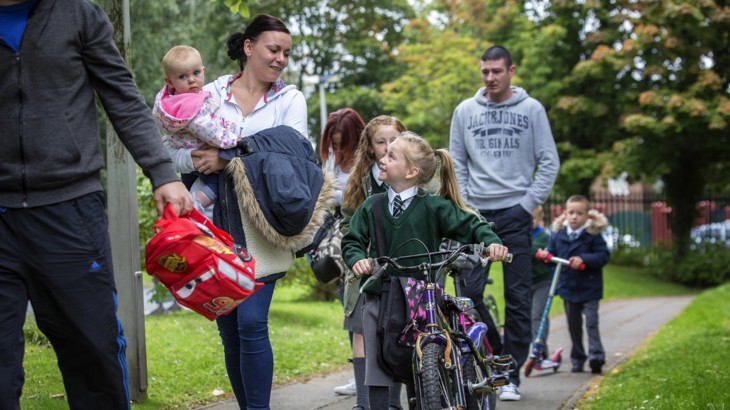Our children are losing their independence and freedom to play outside. They're losing their sense of adventure. Our cities and towns are dominated by cars, making places anti-social. They are often unsafe for children to play and dream. How can a child of seven or eight really defeat the metal giant of the car? Especially, in an environment built specifically to benefit vehicles and transit instead of people.

In our Manifesto for UK Government, Sustrans wants to see things change.
We need a transformation in the way we design our environments.
We need to put our most vulnerable first and build places for them. And some of our most vulnerable are children – so let’s start with the school journey.
Why change is needed
The number of children being driven to primary school has been increasing since 1995. Now, as many as one in four cars on the road during the morning peak are on the school run.
It is, therefore, no surprise that traffic danger is the most common reason cited by parents for not letting their child walk or cycle to school.
At a time when life expectancy is decreasing, child obesity is on the rise and air pollution is damaging everyone’s health, it is clear we must take action.
We know it’s possible to get more children walking and cycling the school journey and to create inviting, safe environments for them to do so.
In the Netherlands, 58% of children cycle to school. If we replicated this in England, levels of physical activity associated with walking and cycling to school would increase by 57%.
How to tackle the school journey
If we want to create places where more children can play, walk and cycle, we need to start with School Zones in neighbourhoods around schools.
Schools Zones should have speeds no greater than 20mph. Infrastructure must be put in place that allows children to get from their home to school in safety and with confidence.
This infrastructure should reduce children’s interaction with traffic wherever possible by including protected cycleways on roads that are highly trafficked or have higher speeds.
School Zones should also reduce overall traffic flow by making cars the guests (that is, the exception rather than the norm) on streets near schools. There are many ways to do this. One way is to filter roads so only residents can enter with cars and the street is only open to foot, cycle and wheelchair for everyone else.
Secondly, for the streets directly outside a school, we should have School Streets.
This involves closing the street directly outside a school during drop-off and pick-up times. This allows children to play and interact with each other outside the school gates in safety.
School Streets are currently difficult for local authorities to enforce, so they need to be given more power by the UK Government to enforce them.
Finally, all nine- and 10-year-old children should receive on-road cycle training. Even with recent announcements of increases in funding, the availability of cycle training is still a postcode lottery. Plus, parents are more confident in allowing their child to cycle when they have had training.
If the next UK Government prioritises all of these things, we should see an increase in the number of children regaining their confidence and independence to travel to school actively.
But, at the heart of achieving this change, is redesigning places for people, not the car, so we can all feel safe walking and cycling.
Children should be free to play and imagine their own superpowers and enemies. They should feel free to fight on their school journey: perhaps a wicked witch, a mischievous wizard or a fiery dragon. They shouldn’t be coming into battle with a real-life metal monster which robs them of their freedom and independence. Let’s build spaces which allow kids to be kids.






